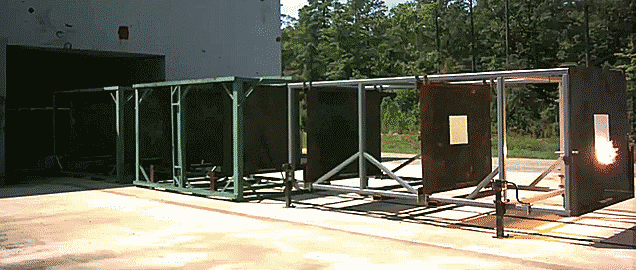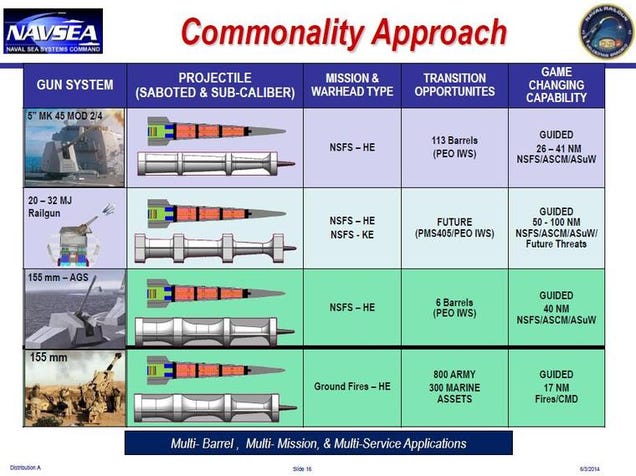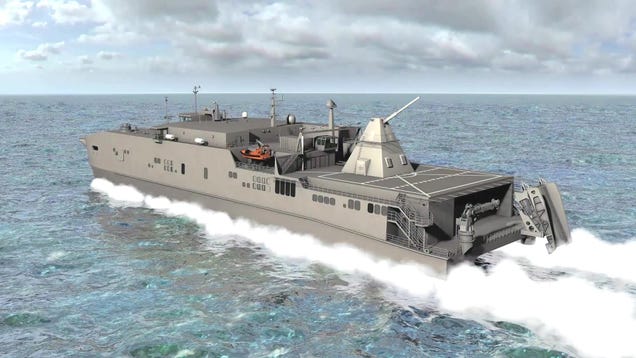
Watch The US Navy's Hyper Velocity Projectile Rip Through These Plates
The Office of Naval Research is getting ready to deploy their electromagnetic Railgun
for testing for the first time next year. But what is a gun without
ammo? The Hyper Velocity Projectile is being built for not the just the
Railgun alone, but also for existing 5 inch deck guns as well. And yes,
it is very, very fast.
The Hyper
Velocity Projectile is basically a flying hypersonic spike and is
launched in a similar fashion as the sabot rounds fired by Main Battle
Tanks. The super low-drag spike of a projectile whizzes through the air
at hyper-velocity speeds (around 5,600mph), hence its name. Oh yeah, and
it is guided.
The HVP’s
sleek design allows it travel much farther than tradition naval gun
shells, from 30 to over 100 miles depending on what it’s fired out of.
Because of its high speed, it can arrive on target very quickly. Using
different programmed trajectories, a whole swarm of HVP’s can land
simultaneously, literally turning an enemy’s silent night into a
hell-storm in a blink of an eye.

Deputy Defense Secretary Bob Work examines the damage caused by a High Velocity Projectile
The
projectile will come in a few different flavors, including an air burst,
a kinetic energy penetrator and high-explosive round. Because of its
high-speed and miniaturized and hardened internal guidance, it could be
used against surface and a ground targets, but it could also be employed
against air threats, as well. Think of it as the ultimate version of
skeet shooting, where each round costs as much as an exotic car.

Although guided artillery-type shells exist, and are very effective,
speed is what makes the HVP so attractive. A whole slew of new
possibilities, many of which make traditional missiles less relevant,
especially for short and intermediate range engagements, exist when you
factor an operational HVP capability into naval warfare scenarios.
If network
connectivity is added to the HVP’s design, it could be guided in-flight
with command updates coming from external sensors. This means it can hit
moving vehicles using a remote sensor’s data, such as from an unmanned
aircraft or a ship’s radar system. Under such a scenario, a HVP could be
launched from 100 miles away, toward an enemy land mass, and a
loitering unmanned aircraft tracking a vehicle could provide the
projectile with terminal targeting information. The whole engagement
would last about one minute.
It also
means that the HVP could one day become more deadly than a
surface-to-air missile, as its speed makes it almost impossible to
defend against. Under such a concept, a Destroyer’s AEGIS combat system,
including its powerful phased-array radars, can track an enemy fighter
20 miles away, and fire off a HVP with its existing 5-inch gun. The HVP
will use mid-course updates from the ship’s radar sent to it via
data-link. The whole engagement would last under 15 seconds, and the
projectile’s speed would make it nearly impervious to evasive maneuvers.
Seeing as
such a weapon would not need to carry its own propellant (or its own
sensors, for that matter), it would mean that, although clearly not
cheap, the HVP could replace some missiles at a comparatively cheap
price. They could also allow for precious vertical launch cells aboard
US Destroyers and Cruisers to be used only for long-range weaponry, such
a cruise missiles and long-range interceptors. This also gives the
Navy’s primary surface combatants many more shots to fire and a whole
new mission of medium and long-range persistent fire support that
currently does not exist. Even a ship’s Close-In Weapons Systems defending against cruise missiles and swarming boat attacks could be augmented by the HVP’s capabilities.
What’s also cool about the HVP is that it can be dumbed down just like it can be smarted up, by removing its Inertial Navigation System (INS/GPS)
along with its data-link and control mechanisms, and filled with more
high-explosives instead. Such a setup would be ideal for long-range
ship-to-shore area suppression and attacks on large fixed targets. In
other words, great for prepping the battlefield for the Marines before a
beach landing.
Another
enticing aspect of the HVP is that it could give foreign allied navies a
huge leap in capability without having to really modify their existing
vessels, as the munition is being built in a common 5-inch gun sized
format. Although this only offers a fraction of the Railgun’s range, it
still is much faster, longer-ranged, and more accurate than any 5-inch
shell available today. Combined with an off-the-shelf radar system, the
HVP could give ships that were designed for surface warfare and hunting
submarines an area air-defense capability on the cheap.

The Railgun will be tested aboard the Navy’s Joint High-Speed Vessel USS Millinocket (JHSV-3) next year.
Finally,
for future ships toting a Railgun, the HVP would be fired without any
explosive propellant, making the ship a safer place and less prone to
horrific secondary explosions caused by battle damage or accidents. It
could also mean that someday, in the not-so-distant future, we might see
the return of ships packing multiple big guns. The DDG-1000 Zumwalt
Class, with its two 155mm guns is a start, but even a pocket “Electronic Battleship” could be a real possibility.
Tyler
Rogoway is a defense journalist and photographer who maintains the
website Foxtrot Alpha for Jalopnik.com You can reach Tyler with story
ideas or direct comments regarding this or any other defense topic via
the email address Tyler@Jalopnik.com

Post a Comment Blogger Facebook Disqus